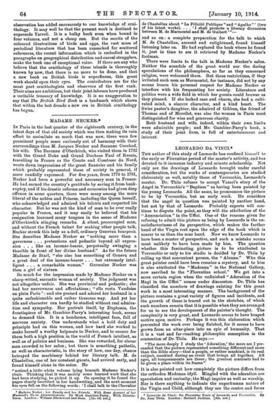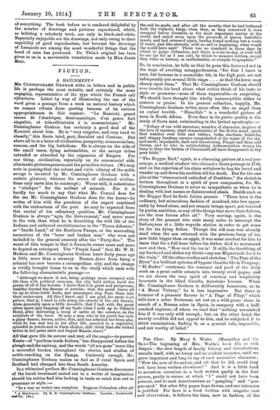LEONARDO DA VINCI.*
Tuz author of this study of Leonardo has confined himself to the early or Florentine period of the master's activity, and has devoted to it immense industry and minute scholarship. Not only are the drawings of Leonardo brought under careful consideration, but the works of contemporaries are studied elaborately as well, notably those of Verrecchia Leonardo's master. Dr. Thiis refuses to accept Vasarrs story of the Angel in Verrocchio'e "Baptism" as having been painted by the young Leonardo. All the same, he pronounces the picture to be by Verrecchia but an early work. He considers that the angel in question was painted by another band, but not by that of Leonardo. Probably experts will con- tinue to dispute the point, as they will the attribution of the "Annunciation" in the Uffizi. One of the reasons given for refusing to admit this picture as being by Leonardo is the un- satisfactorinem of its perspective, which makes the further hand of the Virgin rest upon the edge of the book which is nearer to us than the near hand. Now we know Leonardo to have been &master of perspective, and such a mistake seems most unlikely to have been made by hint The question whether this fascinating picture is to be attributed to Verrocchio or only to his studio is decided by Dr. Thiis by calling up that convenient person, the " Alunno." Who this great painter could have been remains a mystery, and to him is also attributed the "Madonna" in the National Gallery, now ascribed to the "Florentine school." We get into a more certain region when the unfinished " Adoration of the Magi in the Uffizi" comes under discussion. Dr. Thiis has classified the numbers of drawings existing for this great work in a most interesting manner. The background of the picture contains a great variety of figures and incidents, and the growth of these is traced out in the sketches, of which suoh numbers remain that it is possible when they are arranged for us to see the development of the painter's thought. The complexity is very great, and Leonardo seems to have heaped motive upon motive. Perhaps it was this elaboration which prevented the work ever being finished, for it seems to have grown from an altar-piece into an epic of humanity. That it is a vast and far-reaching philosophic conception is the contention of Dr. Thiis. He says :- "The more deeply I study the 'Adoration,' the more am I per- suaded that the picture represented something differentand more than the Bible story—that a people, or rather mankind, is its real subject, mankind during an event that brings all together. All ages, all temperaments are there ; the greatest contrasts had to be given a place within its frame."
It is also pointed out how completely the picture differs from the orthodox Madonna idyll. Mingled with the adoration are speculation and curiosity; the Magi inquire as well as woe-ship. Nor is there anything to indicate the superhuman nature of the Virgin and Child, although they are the centre and focus • Leonardo da Vinci: the Florentine Year, of Leonardo and Verrooehio. By Dr. Jens Thiis. London: Herbert Jenkins. 140. net.] of everything. The book before na is tendered delightful by the number of drawings and pictures reproduced, which, as befitting a scholarly work, are only in black-and-white. Especially enjoyable are the drawings, not only owing to their capability of good reproduction, but because the drawings of Leonardo are among the most wonderful things that the Land of man has produced. Dr. Thiis's original has been given to us in a serviceable translation made by Miss Jessie Hair.







































 Previous page
Previous page